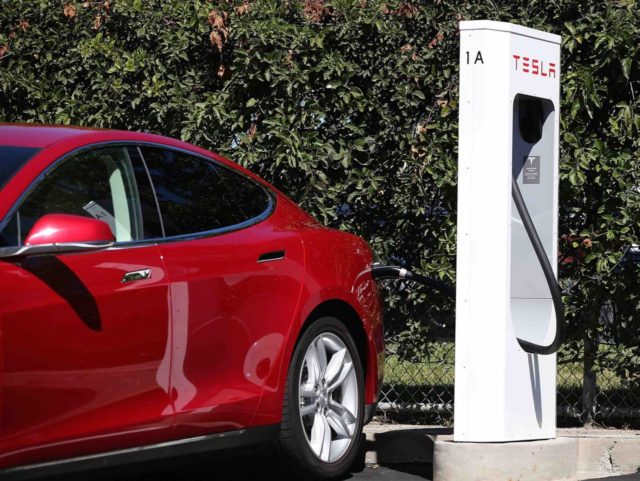California’s zero-emission-vehicle registrations jumped 29 percent last year, powered by government subsidies, but a lack of standardized charging stations will make future growth more expensive.
Gov. Jerry Brown has led the effort to subsidize California’s rich into driving zero-emission vehicles (ZEV) with free charging. The biggest beneficiary of federal and state subsidies was Tesla Motors, which is building what it calls a proprietary Supercharger network that it says will serve as a “moat” to keep the competition at bay.
Last year saw the ZEV share of California’s registrations reach 4.5 percent, or 337,483 units. That was up from 3.6 percent, or 257,400 units, in 2016.
Gov. Jerry Brown and his Democrat allies in the legislature say they are committed to providing subsidies to get California’s ZEV registration share up to 20 percent, or 1.5 million units, by 2025, and then to 60 percent, or 5 million units, by 2030.
As California ZEV registrations jumped by 29 percent in 2017, worldwide ZEV registrations jumped from 500,000 in 2016 to over 1 million in 2017, with international automakers offering over 150 ZEV models.
Los Angeles’ Beacon Economics and Silicon Valley’s Next 10 think tank just published a report titled “The Road Ahead for Zero-Emission Vehicles in California: Market Trends & Policy Analysis.” The report found that for most ZEVs, the cost of batteries is the most expensive component for determining the range and the operating costs. But over the last seven years, battery costs per kilowatt fell from about $1,000 per kilowatt hour to about $209. Even if California’s ZEV sales growth slows, the researchers claim that California will “meet its 1.5 million ZEV goal by 2025, if not before.”
Next 10 founder and well-known environmentalist Noel Perry commented: “The trends in California are all good for the continued increase in sales of electric vehicles.”
But the report warned that California only has reached “16,549 public charging outlets. Although the most in the nation, that only works out to “0.05 per each zero-emission vehicle on the road in the state, one of the lowest ratios in the country.”
Tesla accounted for 1,000 proprietary Superchargers in California, along the 5 Freeway from L.A. to San Francisco, and in towns like Baker and Barstow on the way to Las Vegas.
Tesla’s Panasonic batteries, built at their Nevada Gigafactory, coupled with their Superchargers, do have the highest “headline” charging rate in the industry. But competitors like Jaguar, Audi, and General Motors use LG battery cells in combination with CCS chargers, which charge to the 80 percent capacity range much faster than Tesla.
California has had a free-for-all as it has built its highly-subsidized charging stations. As a result, there is a “disarray of charging currents, a babel of competing connectors, and a land-grab mentality in acquiring suitable real estate,” according to Seeking Alpha’s Simon Mac.
Given that Teslas are built in California, the state will likely have to continue to pay higher subsidies to support at least two or more different sets of charging station networks for the foreseeable future.

COMMENTS
Please let us know if you're having issues with commenting.